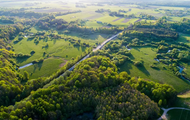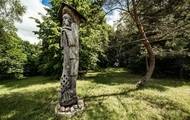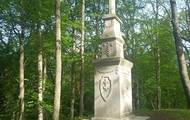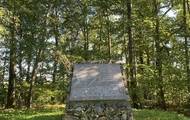Skomantai Mound and the Monument for the 10th Anniversary of the Lithuanian Independence and the 5th Anniversary of the Annexation of Klaipėda Region
This is one of the most impressive mounds in the Klaipėda region and one of the best-established mounds in the whole of Lithuania, dating back to the days of the Teutonic Order. It is also referred to as Ragokalnis. The highest point of the hill features a concrete monument for the 10th anniversary of the Lithuanian independence and the 5th anniversary of the annexation of Klaipėda region, the construction of which was initiated by a farmer, Pranas Kučinskas, in 1928. The monument was designed by Kostas Rimeika. The border between Klaipėda region and the rest of Lithuania stretched not far from the mound as well. At the foot of the mound, there is a wooden statue Samogitian, a symbolic guardian from the enemy, carved by the folk artist Vytautas Majoras in 1969.
Skomantai mound entwines remnants of both the great battles with the Teutonic Order, and the 20th c. history of the Lithuanian statehood.
The mound (Ragokalnis, also known as Papilys) is established on a promontory on the right side of Veiviržas river. Its top is 80 m long and 57-40 m wide. The western side has a bank, which is 60 m long, 20 wide and 8 m high with a ditch that is 5 m wide and 0.7 m deep on the outer side, followed by two more banks, separated by two ditches. The eastern side of the top has a bank, which is 38 m long, 1 m high and 10 m wide (excavated in the middle). On the outer side of the bank, 6 m below, there is a ditch that is 3 m wide and 0.5 m deep, followed by a second 0.5 m high and 4 m wide bank. The slopes of the mound are steep, 20-22 m high. The mound is overgrown by deciduous trees and features a concrete monument for the 10th anniversary of the Lithuanian independence on the western bank.
The foothill settlement used to be located in the 1 ha area west of the mound, featuring archaeological finds of coarse, smooth and rimmed ceramics. In 2010, archaeologists have found traces of yet another settlement on the eastern and south-eastern foothill of the mound. 500 m north of the mound there is a 3rd-13th c. grave site (researched in 1909).
The mound was researched by the Count Pliateris back in the 19th c., but no data of the research has survived to this day. In 1903, the south-western part of the top was researched by Liudvikas Kšivickis, who excavated two pits and discovered a cultural layer thicker than 60 cm. The mound dates back to the 1st-13th c.
Skomantai mound is a subject of 22 legends. Some people say that there used to be a fortress of the Lithuanian dukes, which was the home of the ruler of Samogitia. They also mention that pagans used to gather here to worship and bring sacrifice to the old gods. Legends often involve Swedes, saying that they had buried their plunder in the mound and that the money keeps haunting the surrounding areas. According to other tales, the Swedes had surrounded the people living on the mound, but had to run, as the locals tricked them: they caught a lot of bears, covered them in tar, set them on fire and released them against the Swedes. The roaring bears then ran into the enemy, which was forced to retreat. Some people also speak of a dog running around with a bell. Some others yet – of a horse, or a headless horse running up and down the mound and then disappearing.





